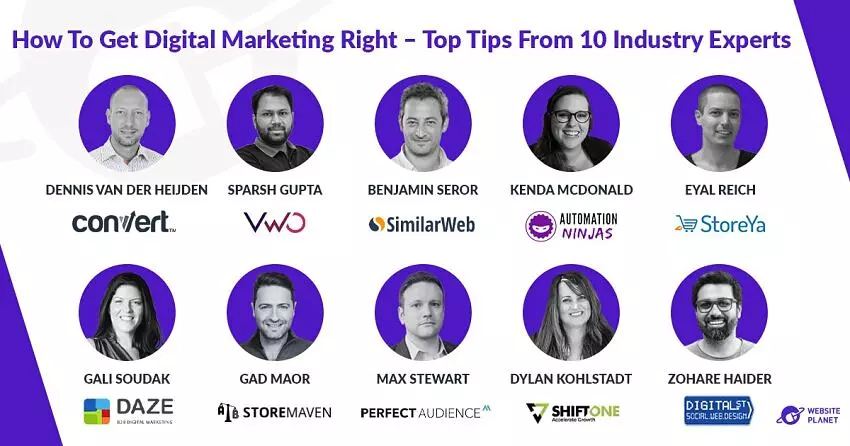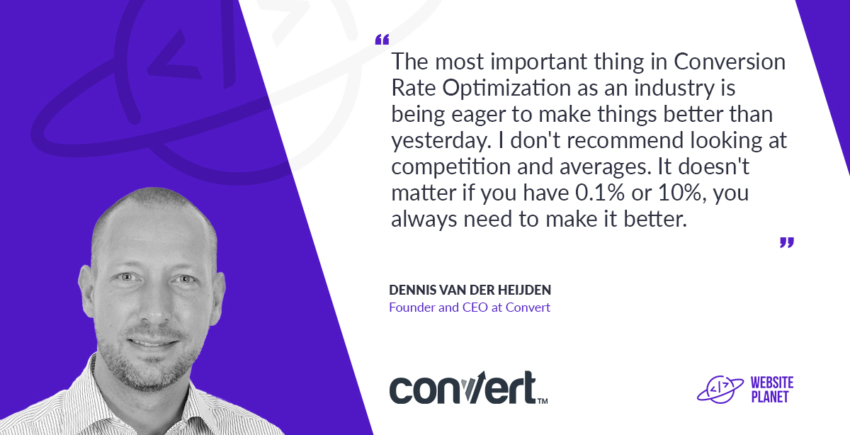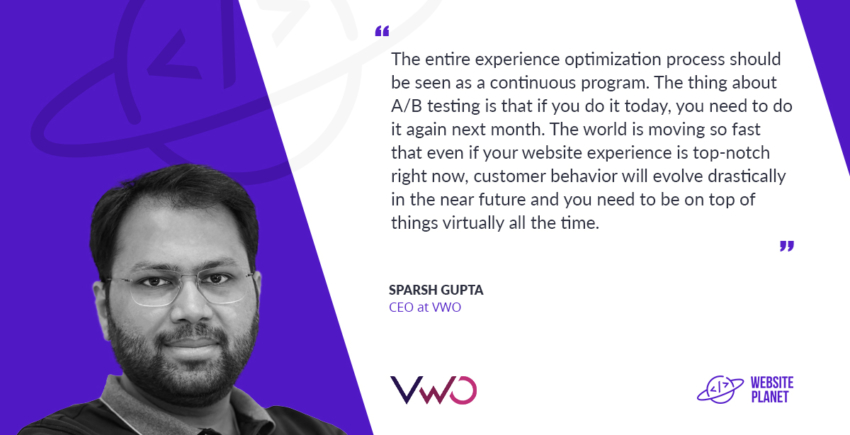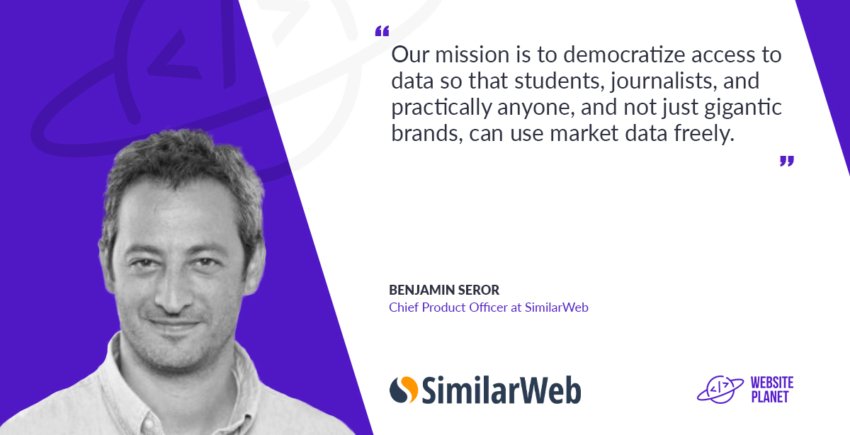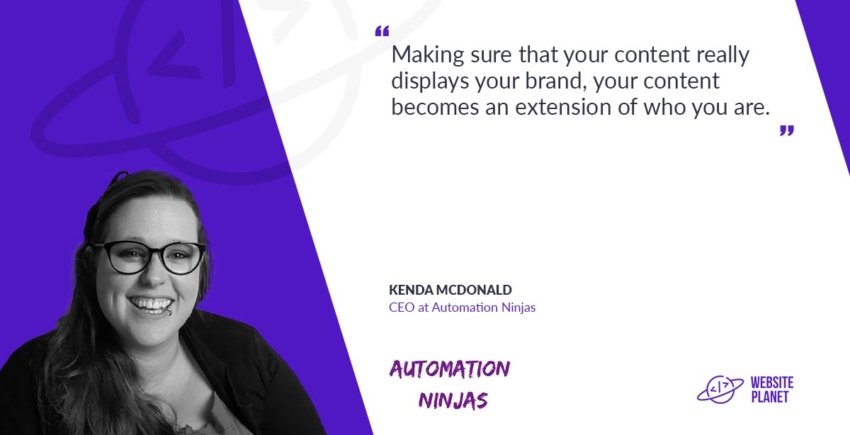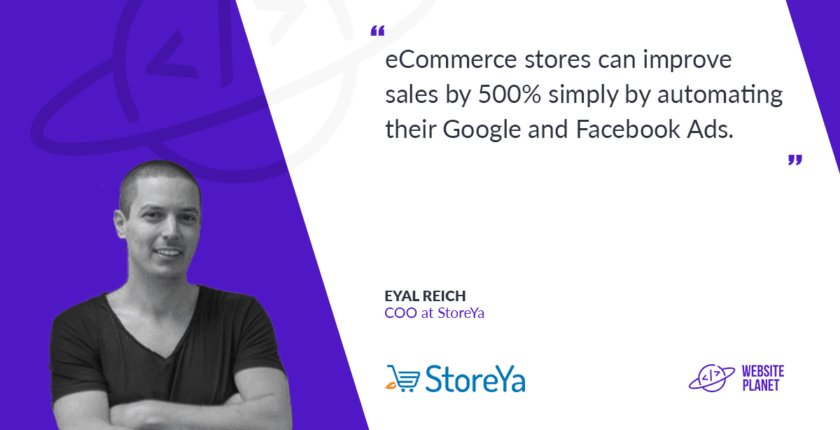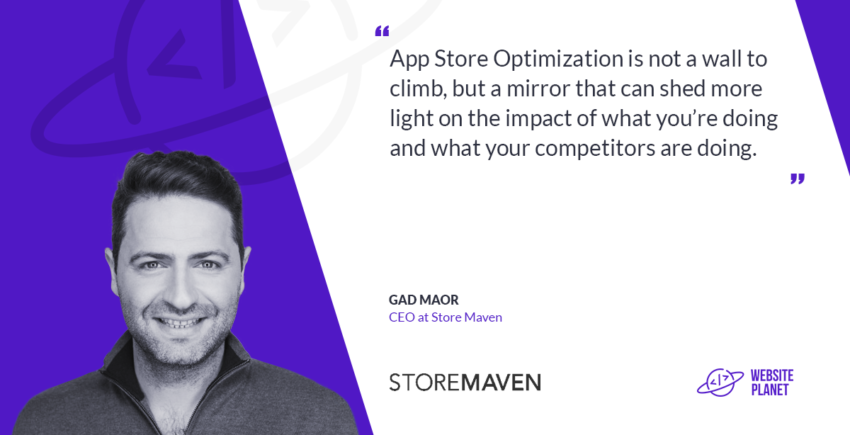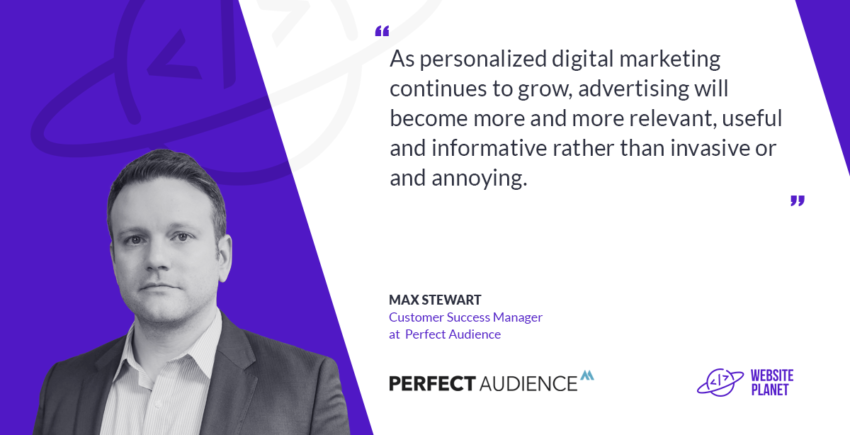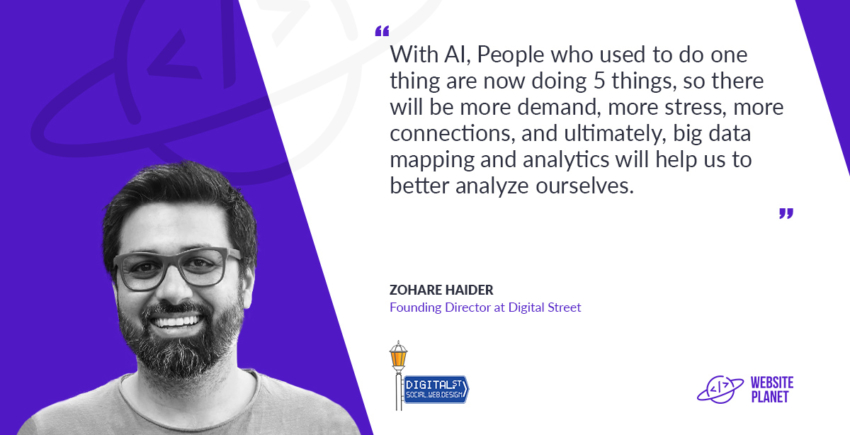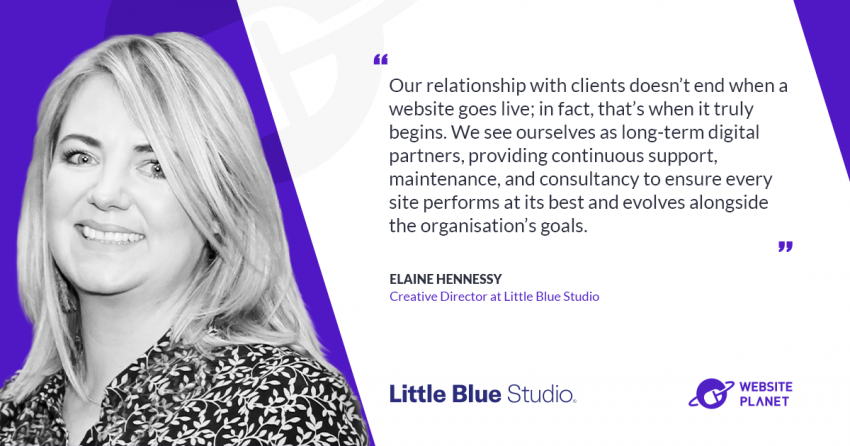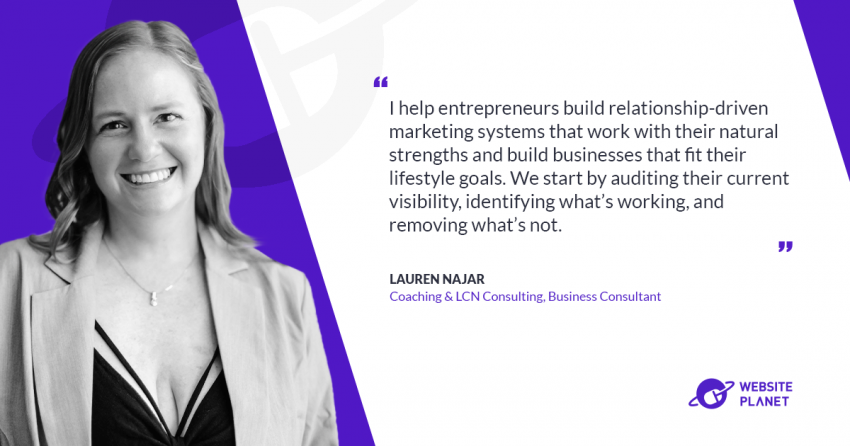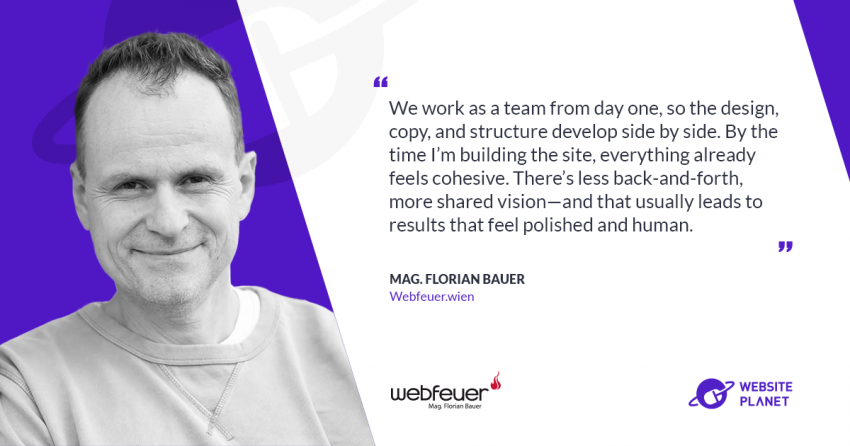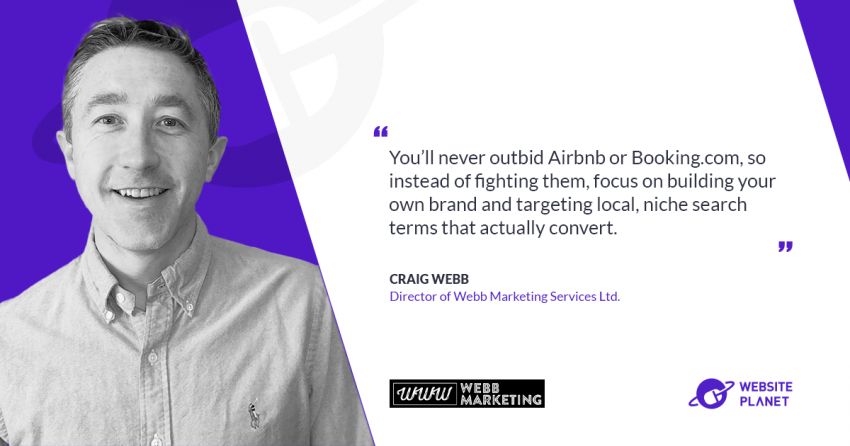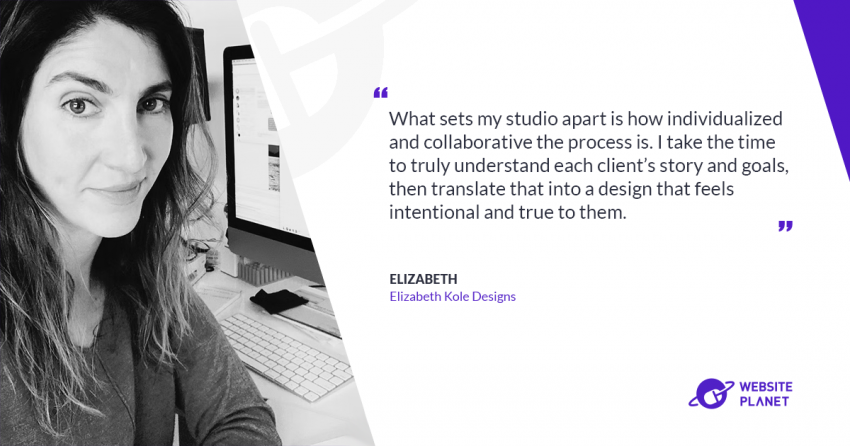If you’ve been following this blog, you probably noticed our interview series, where we talk to top-level executives from the digital marketing industry and ask them about their personal views on where the industry is going, which technologies excite them, and what they think digital marketers should be focusing on to achieve their goals.
In this article, I went back to all my previous interviews where I asked renowned experts in their field for their recommendations on how to be a successful online marketer.
Of course, digital marketing is a huge topic that covers many areas of expertise, so while doing this, I tried to look for answers that will cover all areas of digital marketing, from social media and Chatbot automation to user experience optimization and B2B lead generation.
The following paragraphs present 10 of the most interesting and inspiring recommendations that I got from interviewing over 50 marketing experts about how to be a successful digital marketer. Keep scrolling if you’re ready to be enlightened!
Conversion Rate Optimization
What are the most fundamental things that every digital marketer should know about conversion rate optimization (CRO)?
Answer by Convert CEO Dennis Van Der Heijden
The most important thing in CRO as an industry is being eager to make things better than yesterday. I don’t recommend looking at competition and averages. It doesn’t matter if you convert at 0.1% or 10%, you always need to think about making it better.
Being curious is the key because there’s no hack or tool that will work for you. For instance, you’re not going to make more money simply by installing Convert on your website and launching tests. What it really comes down to is wanting to find out why people are frustrated, what their problems are, and what’s stopping them from converting. The answers lie in usability testing, user behavior research, heat map and data analytics, survey responses and more. You’ll find them if the questions bug you enough.
Everything you do before A/B testing is to see what people are doing. So find out where people have a problem, and try to create a hypothesis about why it’s happening.
For example, one of our customers spotted in their heat map that 15% of the people who visited their cart page clicked the cart icon at the top of the page. But why would you do that if you’re already on the cart page?
The hypothesis said that people thought clicking the cart icon would take them to the next step — the checkout page. Which wasn’t happening in this case. Clicking that button reloaded the exact same page, leading those 15% to believe there was something wrong on the website.
So based on the hypothesis, this customer decided to take that icon and direct it to the checkout page, resulting in a 4% increase in revenue in that quarter alone. Fascinating, isn’t it?
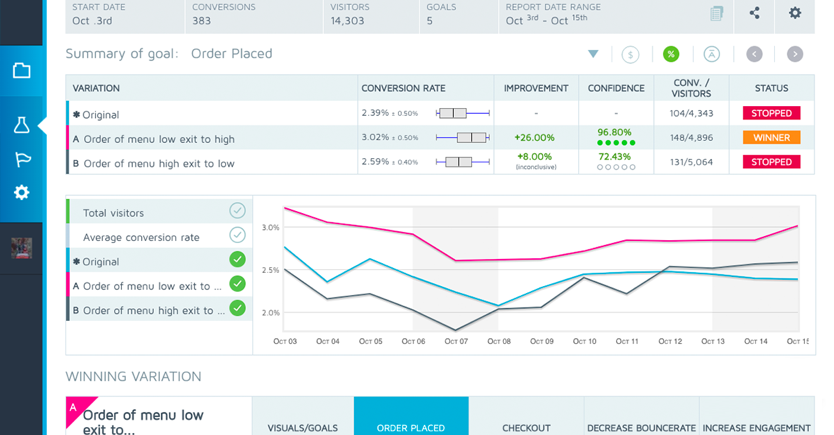
Just by being curious and asking the right questions, they managed to remove the frustration of reloading the page. Thinking that users who did it were silly for not knowing what the cart icon looked like wasn’t going to solve the problem. But as they were already clicking it, just changing the icon’s URL increased the revenue by 4%.
Another thing is to not feel discouraged if you don’t have enough traffic to support A/B tests and other experiments. Because not being ready for experiments doesn’t mean you can’t optimize for more conversions. Just dig into whatever data you have, and when you do it right, you’ll still spot multiple areas for optimization, which will usually have a monetary value associated with it.
Errors, for example. Just run your website through a diagnostic tool and it will flag all the errors you have. You don’t run tests on errors, you just remove them.
Slow loading pages need to be improved too, period. Again, there’s no need for A/B testing here, just make it load in 2 seconds.
Test your forms! Are they working properly on all browsers, devices, and operating systems? Again, capture errors, particularly JS errors! There’s a massive amount of money that can be saved just by removing errors, and you don’t need Convert.com for that.
Conversion is not an easy industry to be in, it’s more for mature companies whose websites get 200,000 visitors or more per month. When you have time, a developer, and a researcher to be able to do those things, or you can hire an agency, that’s when you can expect to move the needle.
Some automated tools do their magic. But Convert.com is not one of those solutions. We can only help hardworking people who are curious enough to do their work effectively.
Customer Experience Optimization
What are the most fundamental things that every digital marketer should know about Customer Experience Optimization (CRO)?
Answer by VWO CEO Sparsh Gupta
Firstly, there has to be a strategic process and timeline around experience optimization. I’ve seen thousands of customers and marketers trying the ad-hoc approach. Once in a while, they will run a few tests for a campaign, or think about optimizing their user experience, but will fail to get results and abandon it altogether.
The entire experience optimization process should be seen as a continuous program. The thing about A/B testing is that if you do it today, you will need to do it again next month.
Stay up to date! The world is moving so fast that even if your website experience is top-notch right now, customer behavior will evolve drastically in the near future and you will need to be on top of things virtually all the time.
What I’m also seeing, from an A/B testing and CRO standpoint, is that getting more winners is tougher. When I say winners, I mean campaigns where the hypothesis was verified and validated. There are also campaigns where the hypotheses are false, so moving from 50% to 60% is hard.
You need to accept the fact that more than half of your campaigns will not result in winners, and that’s okay; it happens to some of the most optimized websites. Even the most sophisticated campaigns fail by more than 50%, so you should not give up. The idea is to constantly keep testing.
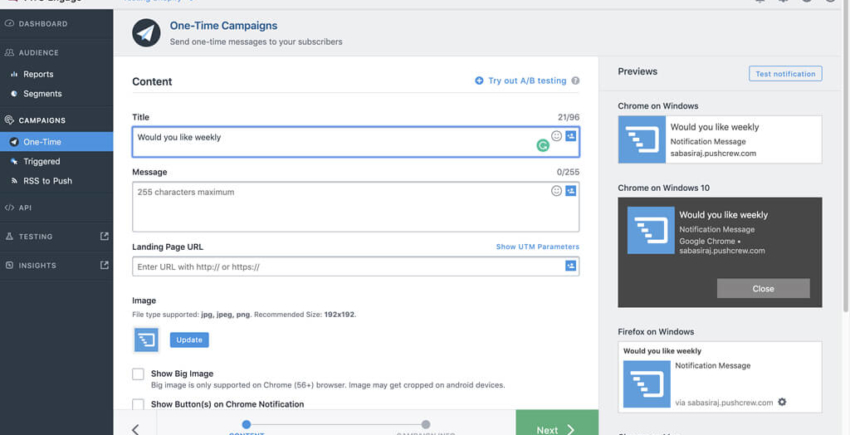
I’ve seen teams that focus on a number of tests and experiences who were able to optimize better over time and get more results than those who were focused on getting just one test right. Even if you do a lot of planning, there’s still a probability that your test will fail.
You need to go with a data-backed hypothesis, but don’t be extremely detailed about the hypothesis because it’s the testing velocity that matters. Having more campaigns is far more important than just sticking to one and perfecting it.
As far as experience optimization is concerned, it’s not just about A/B testing to create superior customer experience on your website; it’s the entire communication with that customer across all touchpoints that matters. It can be your website or app, social media, emails, or any other touchpoint that impacts the customer experience and affects your conversion.
Web Analytics
What would you recommend for a brand seeking to become an industry leader?
Answer by Benjamin Seror, Chief Product Officer at SimilarWeb
In order to become an industry leader, the most important thing to do is to provide value. If you’re just building a brand as a goal, it will be difficult to keep people interested. Focus on the value you’re delivering to the world and on your mission, and strive to be the best at what you do, regardless of the market size.
This is what we try and do at SimilarWeb. You as a user have been using us on the free version, that’s part of our mission. Our mission is to democratize access to data so that students, journalists, and practically anyone, and not just giant brands, can use market data freely.
So, when we were building that logic, we were focused on our mission to make data accessible, and it became really powerful. We started to get fans, evangelists and advocates who absolutely loved us. When you create such a feeling among your target audience, this is when you become an industry leader.
So, how do you make people advocate for you? By being authentic and true to your mission, and really bringing value to those people.
Tactically, you need to be able to distribute and propagate your vision. For us, SEO was the main thing. We didn’t want to pay for advertising, but to build a community as we measure the digital world. Since it was something that a lot of people cared about, we focused our strategy around the idea that our community members are our best ambassadors and advocates. There is no single tactic that works other than being very consistent with your mission.
Learn more about SimilarWeb in this introduction video:
Marketing Automation
What are the psychological factors that marketers tend to miss, and what are your tips for including them in a marketing strategy?
Answer by Kenda Macdonald, Founder & CEO at Automation Ninja
The biggest miss is not using psychographics to profile your ideal audience. These are things like Interests, Attitudes/ Activities, and Opinions, or IAO variables, that will help you understand what information your audience wants to see, where they want to see it, and the kind of information they would respond to best. It helps you to get to know your audience on a human level.
Then there are biases that we can use to make our content convert better. Things like the anchoring effect, using the first piece of information you see to compare or contrast the rest of the information. Then you can go deeper with Coherent arbitrariness and cognitive demand, ingroups, and outgroups. Psychological bias is powerful in marketing.
Next is the awareness level of the audience. As marketers, we easily get caught up in creating content, and it’s easy to forget to ensure that the content is at the right level for the audience.
Because there are thousands of tools out there, the first thing I would suggest is to be very clear about what you want to achieve. So, mapping your audience and planning your strategy should be the first step, to help you find the tools that best match your marketing goals.
Secondly, focus on keeping your audience engaged. Don’t just sell, give them valuable content that they will consume. We recommend taking all the content you already have and distribute it to the existing audience. Utilize that content and make sure you’re adding value.
Thirdly, if you are sending communications out all the time, make sure you’re tracking the behavior. Are they opening your emails? Are they clicking on your links? Are they spending a long time on specific parts of your website?
That kind of information tells you what people are interested in, so you can segment them behaviorally. On the other hand, if people aren’t doing those things, it tells you what they’re not interested in and what you should do earlier on to create better engagement.
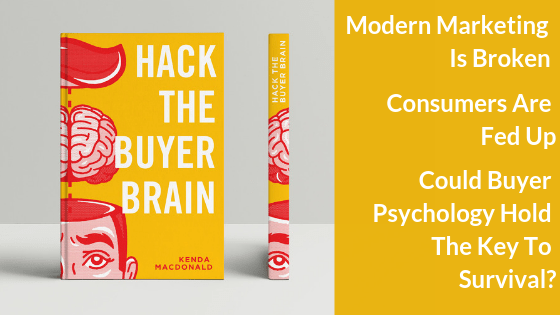
eCommerce
What are your top recommendations for increasing conversion?
Answer by StoreYa COO Eyal Reich
There are a few things you can do that are all easier said than done.
First and foremost, you need to focus on a niche. Don’t open a general store, selling multiple products from different categories. Build a brand and start to promote your best-selling product with promotions. Try to be as communicative as you can, as that is the value of SMB’s over monsters like Amazon. You get the option to be personal with your target audience.
Add a chat widget like messenger or WhatsApp on your website. Try to provide the best support possible, and give your customers the right advice at the right time. You can improve sales by at least 20% just by providing the right support at the right time.
Try to provide the best shopping experience in as few clicks as possible, from the homepage to the product page to the checkout page.
Don’t force users to open an account, and minimize checkout fields as much as possible.
Make use of familiar trust badges by stating “secure payment by XXX”. You need to show that your site and payment system are secure. Make your audience feel comfortable to complete the checkout process as quickly as possible. Doing all of that will increase conversion and decrease cart abandonment.
We also see that in order to improve conversions you need to offer promotions with banners, pop-ups, and other eye-catching elements. Regardless of how you do it, it’s really a must. You’re competing against bigger players and they are providing promotions.
You don’t have to offer large discounts. An offer of 50% off could sound fishy and smell too much like a scam. Provide a promotion that is real for your clients. According to a case study where we tracked the behavior of 30 million users in the US, the sweet spot for online promotions is between 10-15% discount. So offering discounts is important, but don’t overdo it.
Another thing which is important is to create a great product description. A lot of people tend to not focus on the product description but it really is a must. The majority of customers still prefer offline shopping, because they can examine the products closely. You need to be able to resemble that experience by making your product descriptions as detailed as possible. If you write 2 lines on each product, your bounce rate will be high because you didn’t provide enough information or you didn’t have the right tone of speech.
You should try to find out what lingo is perfect for your audience according to geography and demography. Humor can be quite useful if it fits with the brand lingo. Essentially you want to create a sales pitch that is perfect for your specific target audience.
Watch the video to learn more about StoreYa.
B2B Outbound marketing
What are your tips for successful outbound marketing?
Answer by DAZE Founder & CEO Gali Soudak
Unlike many other things, outbound marketing requires a very proactive approach. Think about telemarketing or tele-meeting. That’s a pure outbound channel, it means you go out there and get the client. You call them, you email them, you text them. Throughout the years there have been many different systems and tools to do this, but it’s basically direct outreach to your target market and people do it through many channels.
When you focus on B2B, obviously LinkedIn and Twitter are the main tools, but if you learn how to target wisely you can also do it through Facebook, Email, and many other platforms.
Of course, you have to be very aware of spam laws and legal limitations, but you also have to do it in a fair, honest way. Most companies that try to do outbound marketing fail to reach their desired results, and it’s obvious why, because when you reach someone who hasn’t been nurtured, who doesn’t know your brand, most people won’t like it. They don’t like to be sold to, they don’t like to be bugged, and they tag you as a spammer.
There are systems and best practices to do it in a way that actually works and creates business opportunities. The advantage is that it’s very immediate. Usually, it takes about a month to set up the system in the right way, but once it’s set up and you launch an outbound campaign, the next day you have leads, and I’m talking about sales qualified leads, people who are ready to schedule with you or order from you.
This is a big advantage when you operate in markets like Israel, where people are not very patient to long term marketing. They want ROI the next morning and this is one channel that helped us grow significantly. We were the first in Israel to offer it and for years we were the only company that did it. I know that now there are a few other agencies who offer it, but because it’s such a tough channel to succeed in, I don’t think they were able to really crack the best practices on how to make outbound work.
The other thing that is unique about us is that we offer a channel we call Thought Leadership. What we found is that people like to follow people more than they like to follow brands. This works whether you like the brand or not. So I can give you 2 names: Microsoft and Apple.
I’m pretty sure that when I say Microsoft, you don’t get a pleasant feeling in your body, but when I say Apple, that’s a completely different story!
People are in love with Apple, and still, most of them would rather follow Bill Gates than to follow Microsoft, and when Steve Jobs was alive, one of the reasons Apple was so successful is that he did Thought leadership and influencer marketing. They liked following Steve Jobs even more than they liked following Apple.
When you upload valuable content and participate in group discussions, you show your target audience that there are expert leaders in this company; thought leaders that your target market wants to follow; so soon enough you will start attracting inbound leads, meaning, prospects who start to ask you questions and want to consult with you or meet you.
This means it’s going to be very easy to sell your products and services later on because these people are well nurtured, they come with the knowledge that the people who manage this company are experts.
We see amazing results in this channel, and very few agencies are engaged in such services. They mostly focus on brand awareness, ad exposure and inbound marketing in general, but not through personal profiles. So I would say Outbound and thought leadership are two very strong points that make us unique.
Lastly, we are very data-driven, so everything we do is measured; whether it’s outbound marketing, thought leadership, brand awareness or SEO, everything is measured to the extent that very few agencies do. We optimize campaigns on a weekly basis, just to improve our results. At the bottom line, it makes a huge difference.
Hebrew speaker? Watch Gali Soudak’s Fascinating lecture on how to generate leads on LinkedIn.
Mobile marketing
What are the Fundamental Principles of Good App Store Optimization (ASO)?
Answer by StoreMaven CEO Gad Maor
I’ve spent a lot of time thinking about the market and criticizing old beliefs about what optimization actually is. Optimization is about taking something good and making it better, making the most of it.
The optimization market started with 2 pillars:
- Optimizing creatives to get more conversions. I can upload icons, screenshots and any visual information that will make my app more appealing to the specific audience I’m targeting.
- Optimizing keywords that help to get more discovery and work better with search algorithms, so that users searching the app store will hopefully find my app.
When we look at app store optimization, it becomes much bigger, not only because of the tremendous value and impact it has on the number of installs, but because of the way we interact with the industry.
SEO and ASO are like the stock market. Everyday companies get listed and traded; then things like PR, word-of-mouth, advertising, and competitor actions make their mark. The audience buys and sells and at the end of each day, everything that’s happened has changed the stock market values. When you look at it from that perspective, the app store is very similar.
When I search for a taxi, will I see Uber or Gett? This is a reflection of what happens on the market. There’s movement, and the ranking changes virtually all the time. It’s a result of something competitors are doing.
We started learning how these actions are reflected in the app store. It’s not a wall to climb, but a mirror that can shed more light on the impact of what you’re doing and what your competitors are doing.
Watch StoreMaven in action!
Remarketing and Retargeting
What are the main key points for getting retargeting right?
Perfect Audience customer success manager Max Stewart
The first thing is to target the right people. It usually doesn’t work when a website has just launched and has low traffic. Having enough people to have a good retargeting audience is one of the main drivers for success.
We provide you with the necessary tools to effectively target individuals who shop for products, click on the pricing page, or demonstrate initial interest. This empowers you to optimize your ad expenditure. You have the option to exclude individuals who briefly visit your site and bounce right away from your retargeting strategy.
Having the right people also means your ad creatives don’t simply address their need or the problem they are looking to solve, but also that your copy matches the landing page they came from and the offer that you have made for them.
Many times I see a difference in the design, style or offer, and the ad doesn’t look anything like the original page that the users came from. Confusing the viewers like that is never a good idea. Make sure you deliver the right message to the right people and maintain consistency throughout your campaigns.
Next, there are certain industries or businesses where time is a factor. Sometimes purchases begin with an impulse decision, like getting a new t-shirt. This kind of decision can be made within a day or two, so the targeting will focus on people who visited your shop recently, offering the specific product they were looking at.
Other purchases, like travel bookings, have a specified time limit, so you want to focus on recent visitors before they book elsewhere.
If you’re offering a high ticket item or you’re marketing for B2B clients, the purchase decision will usually take longer, so naturally, that campaign will need to be more sequential, and continue for longer periods of time. They will be seeing your ad for weeks or months, staying on their mind is key.
The main thing is to test and refine: test different creatives, see what works, get rid of the ones that don’t work, and start a campaign that targets particular segments. Perfect Audience was built to allow you to easily launch and edit campaigns on the fly.
Sometimes you want to launch a campaign and expect a huge boost in sales, but it usually takes longer to get traction until viewers are more comfortable seeing your ads. 90% of people don’t convert on their first visit but the more they visit, the more likely they are to convert.
Stats show that someone who clicks a retargeted ad is 70% more likely to convert than someone who clicked a regular ad.
Influencer Marketing
What does it take to become a social media influencer?
ShiftOne CEO Dylan Kohlstadt
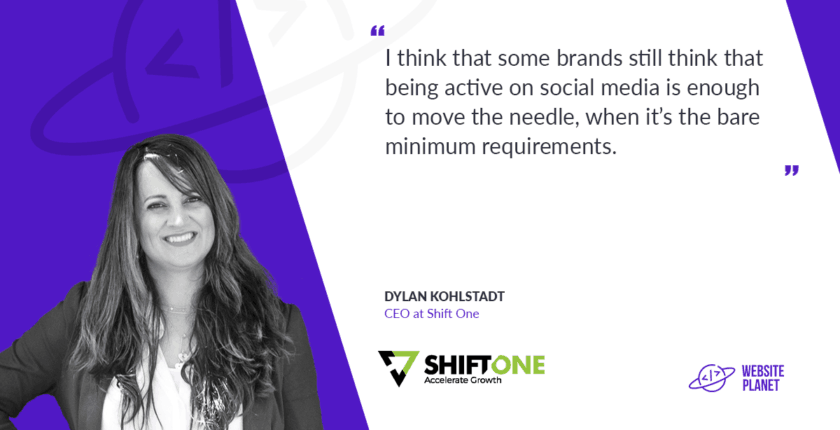
When I created my Instagram account, it was with the express intention of understanding this ‘road to influence’. What would it take to grow a following, across all my social platforms and YouTube, and how would that change my life?
Firstly, I realized that the commitment was huge: I would need to create meaningful content on a regular basis, at least daily. This takes a huge toll, as I am running three businesses, and taking the time to shoot videos, check images, provide content. It’s really time-consuming and requires a real sense of why you are doing this.
For me, the main reason is that I am a teacher. I love to share, and sharing my entrepreneurial journey is very fulfilling for me. Being able to inspire others to join me on this journey, or inspire other entrepreneurs to not make the same mistakes as me, is very important to me and motivates me to create content on a regular basis.
Don’t try to do it all by yourself! When I started out, I hired a videographer and brand manager to follow me around full time, creating content, posting, scheduling, replying and driving the process. Since then, these team members have been booked up with client work (from my digital agency Shift ONE), and so I’ve lost my crew, but by then I was already experienced enough to know what I need to do.
So, to remove all barriers and self-excuses, I started using Canva, and my own video editing software. I am now creating my own content. It might not be quite as sexy, as I usually do it while walking to my car or on the way to a meeting, but at least it gets done and there are no barriers to me making it happen!
Influencers are more believable and trustworthy than brands. The role of influencers is to be completely honest and show integrity. While brands are mostly blinded by their own intentions, and shareholders drive for profits, influencers, who have a broad reach and high level of credibility, are responsible for sharing the honest truth.
Where influencer marketing fails, is when influencers are not honest, or suppress their findings because they are being paid.
Influencers need to be transparent about posts that are paid for, which can be a tricky thing to do, but if they lose their credibility, what will they have left?
The question is, what comes after influencer marketing? Something that is higher in integrity, honesty, reliability, and believability.
Here are some more valuable tips from Dylan’s Video Blog:
Web Development
What are your best tips for brands who want to become successful online?
Digital Street founding director Zohare Haider
If I had to create brand value from scratch, I’d first go back to the basic questions: what do I do, why do I do it, and who is my audience. To be an effective communicator you have to really understand your market and create true value.
As an example, let’s say I have a small grocery store where there is no competition. I have absolute market dominance and a strong, established business, so I have 2 choices: Either I provide good service and keep them coming back because in the future I might have competition, or I provide bad service because I have a monopoly and become complacent towards risk and competition.
Keep your edge! This prehistoric thinking is why many businesses end. Nokia and Motorola wouldn’t be where they are today if they hadn’t acted like that. IBM and Microsoft are the 2 giants that were smart enough to be consistent with what they do and provide great value despite their monopoly. Take away all of those millions of dollars in subscriptions, and they are no different from that grocery store.
You need to have a good supply-demand ratio and understand where you want to be. If you have a strong proposition, you know where you want to be; you know your market and your suppliers, and you place your customers at the heart of the business.
You have to be really in love with what you do and have a tremendous passion to endure the challenges and continuously provide a good service or product.
Summary
We’re living in exciting times of change. 10 years ago, just having your own website was a big deal. Today, it’s already clear to see that Digital marketing goes way beyond web development, SEO and social media. By taking into account all the different layers of user experience marketing, market research, experience optimization, A/B testing, eCommerce, ad networks, social networks, web analytics, artificial intelligence, and machine learning, that’s when you can really get a holistic view of what digital marketing actually means in 2020.
If you found this article useful, please give it a clap to show your support, or add your feedback in the comments below. In the next article, I’m going to browse the most interesting answers I got to the question: How do you see the evolution of digital marketing in 5 years from now?
Stay tuned!
